Cruise Day 43
Speed 7 knots (kts)
Course 256° (WSW)
Location N. Canada Basin, ~650 nm north of Barrow, Alaska
Depth 3243 m
GO DEEPER DISCUSSION: (see previous journal for the questions.)
Arctic foxes aren’t very large predators, averaging under 8 lbs. Most Arctic foxes go to land in the summer where they can hunt small prey on the tundra such as rodents and birds, but there are no such small prey out in the pack ice. Even the smallest seal inhabiting the Arctic ice, the ringed seal, is too large for an Arctic fox to tackle, excepting a limited window of opportunity to hunt pups. So when it is out on the pack ice, an Arctic fox primarily scavenges leftovers from polar bears.
TODAY’S JOURNAL:
We’re experiencing a virtual heat wave today, with temperatures in the 20’s for the first time in a long time. Our sampling station wrapped up this morning and we are heading south with admirable speed by utilizing leads whenever possible and dealing with the remaining ice without much difficulty. Most folks aboard are looking forward to a talent show tonight for a change of routine – I’ll report back on that tomorrow!
Yesterday and today I did some underwater GoPro filming. I stayed high and dry, using a long aluminum pole, usually reserved for fending off ice or snagging errant lines, to hold my camera underwater via a roll bar mount. I thought I’d share a few screen captures of submarine scenery with you for today’s Sunday feature:
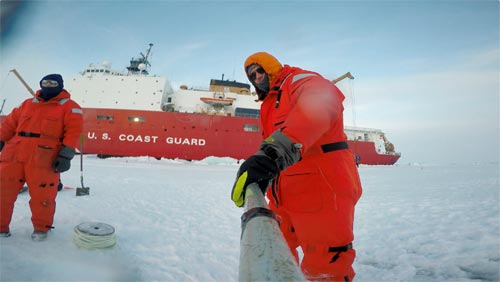 Mark Stephens and Bill Schmoker deploying a sub-ice GoPro with a long aluminum pole, USCGC Healy in the background.
Mark Stephens and Bill Schmoker deploying a sub-ice GoPro with a long aluminum pole, USCGC Healy in the background.
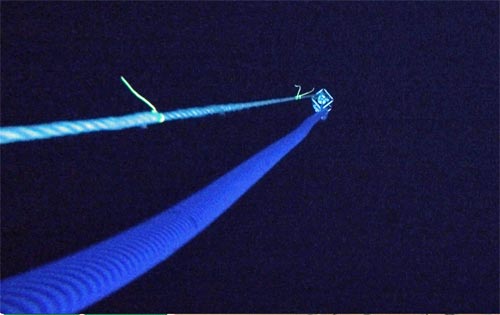 Looking down from under the ice the Arctic ocean water looks black, with a metallic cage holding a CTD and a blue hose for pumping water back to the surface held at the proper depth by the braided line.
Looking down from under the ice the Arctic ocean water looks black, with a metallic cage holding a CTD and a blue hose for pumping water back to the surface held at the proper depth by the braided line.
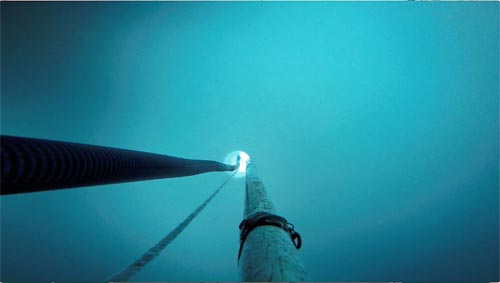 Looking up from under the ice we see the drilled hole, blue hose for pumping water to the surface, line holding the CTD in place at the proper depth for sampling, and the aluminum boat hook pole used to control the GoPro.
Looking up from under the ice we see the drilled hole, blue hose for pumping water to the surface, line holding the CTD in place at the proper depth for sampling, and the aluminum boat hook pole used to control the GoPro.
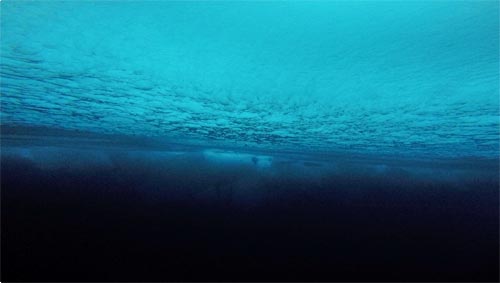 Looking sideways from about a meter under the ice, we see the scalloped bottom surface of the ice and larger blocks in the distance projecting downward under a pressure ridge.
Looking sideways from about a meter under the ice, we see the scalloped bottom surface of the ice and larger blocks in the distance projecting downward under a pressure ridge.
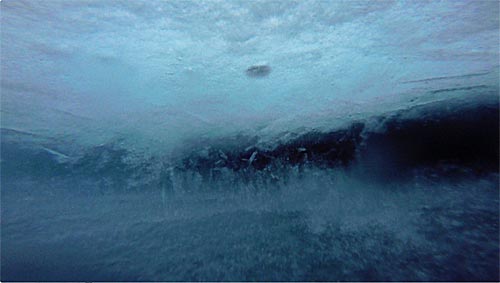 There was a pocket of water partway down the drilled hole with ice crystals growing into it. We think that we drilled through a mostly-refrozen melt pond that still had some liquid water left at the top of the remaining sea ice below.
There was a pocket of water partway down the drilled hole with ice crystals growing into it. We think that we drilled through a mostly-refrozen melt pond that still had some liquid water left at the top of the remaining sea ice below.
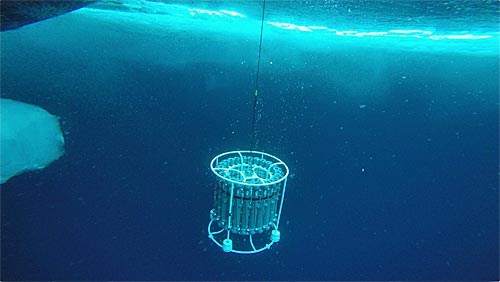 Seal’s-eye view of this morning’s GEOTRACES CTD cast. We were in a newly-frozen lead with just an inch or two of ice that the Healy cleared out, but you can see the thicker sea ice beyond that in the background.
Seal’s-eye view of this morning’s GEOTRACES CTD cast. We were in a newly-frozen lead with just an inch or two of ice that the Healy cleared out, but you can see the thicker sea ice beyond that in the background.
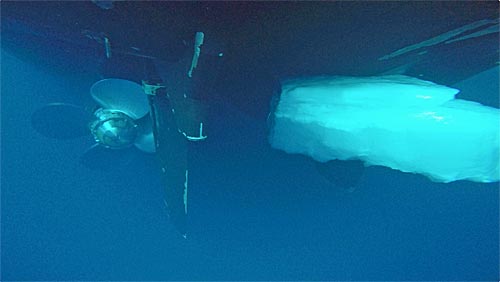 Twisting the pole a little let me look at the Healy’s port-side propeller and rudder. For scale, the propeller is sixteen feet in diameter! Note the block of ice stuck above the starboard rudder, and the big scrapes in the port rudder caused by backing up into thick ice.
Twisting the pole a little let me look at the Healy’s port-side propeller and rudder. For scale, the propeller is sixteen feet in diameter! Note the block of ice stuck above the starboard rudder, and the big scrapes in the port rudder caused by backing up into thick ice.
GO DEEPER!
Here’s a Sunday riddle:
While walking the decks I saw two sailors on opposite sides of the ship. One was looking west and the other one was looking east. And at the same time, they could see each other clearly. How was this possible?
Aloft Con web cam updated every hour
Healy Track
That's all for now. Best- Bill


Comments